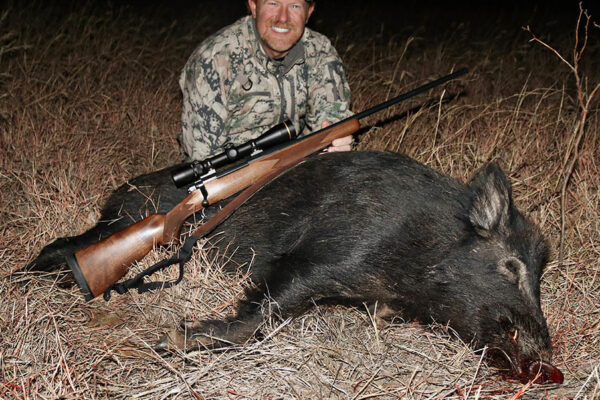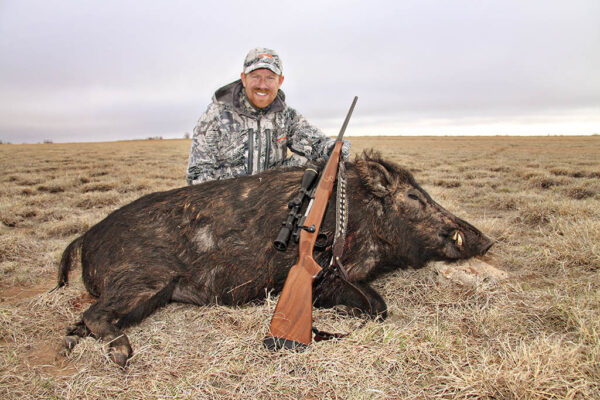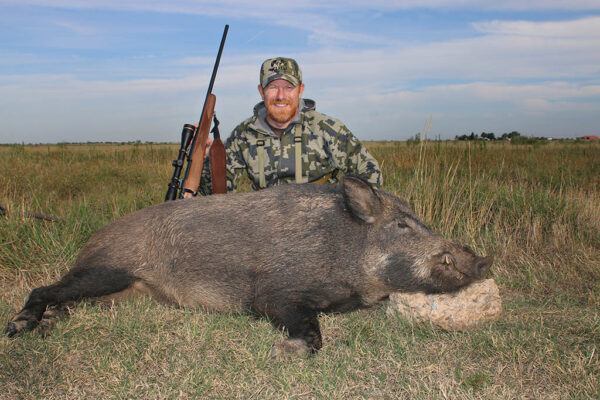By Brandon Ray
The black hog cut through the tall grass right at sunset. He scattered the deer I’d been watching. Deer, whether they’re mule deer or whitetails, do not like sharing space with wild hogs. My deer hunt quickly turned into a hog hunt.
I closed the gap, racing against the fading light. When the boar paused at 100 yards, my crosshairs settled on his shoulder and I tugged the trigger on my .25-06. I followed smears of red on knee-high, yellow grass until I found the dead hog 50 yards later. By the beam of my headlamp, I set up a camera and tripod for a few photos, then loaded the heavy hog.
I felt good about my effort to reduce hog numbers, if even by only one, while listening to the radio and driving back to the ranch headquarters. When I rounded a bend in the road, my headlights lit up 50-plus hogs crossing the road to a nearby wheat field. I saw big ones, little ones, spotted ones, brown ones and black ones. In a place where I never saw a single wild hog as a kid, now there are too many. Such is the story of hogs in Texas.
Rough country hogs
Wild hogs have spread all across the Lone Star state. Rivers and creeks serve as highways for wild hogs to spread their territory. The thick brush, water and good feed along creeks and rivers make for prime hog habitat, but they are adaptive and live other places, too. I’ve seen wild hogs in canyon cliffs so steep it makes an aoudad think twice.
I once sniped a big boar off a cliff and watched him tumble end over end hundreds of feet to the canyon floor. Rugged canyon country provides hogs with lots of cover and food. I’ve glassed hogs miles from cover in CRP fields and ag fields like milo, wheat and peanuts. A herd of hogs will set up residence in a waist-high crop of milo.
The herd lays low during the day, the crop providing cover and food and a random puddle or pond nearby serves as their water source. At night, they feed on the crop, reducing or eliminating the farmer’s profit. A herd of 40-50 hogs can destroy a crop quickly. My neighbors shoot hogs year-round, day or night, to control the damage on their crops.
All that shooting makes hogs tough to hunt in daylight by traditional methods like glassing and stalking or even guarding waterholes or feeders. Even with all that pressure, some hogs reach old age and jumbo size. Here are a few memories from hunting wild hogs in the Texas Panhandle.
Barn Vampire No. 1, 2011
In early 2011, a severe drought took hold in North Texas. I kept a trough near my barn full of corn and alfalfa hay for resident deer. A trail camera tied to a fence post kept tabs on visitors. Deer, raccoons and rabbits frequented the trough. One day, the trough was over-turned.
When I checked the camera, a large boar hog had eaten all the corn and flipped the heavy metal trough. The solo boar returned, no other hogs just him, and always in the dark. For a couple of weeks, that big boar hit the free food randomly. He was unpredictable, sometimes hitting at 10 p.m. and other days at 4 a.m. Then he would vanish for a few days. A small light off the side of the barn roof would barely illuminate him at night if he returned.
I waited for that big boar several nights, sitting and staring at darkness for hours without ever seeing him. Then, one night in March, I found myself wandering the house late at night. I couldn’t sleep. It was 2 a.m.
When I glassed the barn, I saw an ominous shadow at the edge of the beam. It was him! I grabbed my Winchester rifle, tip-toed out across the front yard and rested my rifle on the fence.
It was only 50 yards to the hog, but unless he was standing in just the right spot, I could not see him through my scope. Minutes dragged and the cold night air nipped at my bare hands and toes. I was dressed in pajamas after all. Finally, the hog moved five steps closer to the light.
I could plainly see the silhouette and his chunky shoulder through my scope. At the rifle shot, I heard the bullet from my .270 connect with meat and bone. The old boar made it only 40 yards before expiring, shot through the top of the heart. The next morning, this time dressed in warm camo clothes, I took pictures next to the barn-raiding, vampire hog. He weighed an honest 320 pounds. His white skull with needle-sharp tusks sits in my office today.
Barn Vampire No. 2, 2016
It’s not unusual for deer to meander through the barns and yards at the ranch headquarters. Sometimes it’s a nice buck, but mostly it’s a doe, fawns and small bucks. Wild hogs occasionally pass through, but they rarely stay.
The summer of 2016 was different for some reason. Hogs made wallows around the water faucets by the corral and muddy rubs showed up on fence posts and trees. They ate corn from the trough intended for the deer and they ate mineral blocks. Multiple times, a marauding herd of hogs even tried to dig up the grave of one of my favorite ranch dogs under a tall pine tree, despite heavy rocks and a cross marking the sacred spot.
That was too much. It was war. So, I started waiting for them at night.
Like five years earlier, one lone boar made regular visits. He never came with a herd, always by himself. And like five years earlier, he was a regular visitor but unpredictable at the same time. One night he would feed at 11 p.m., the next night at 3 a.m. Then he would vanish for three days, then come back again. His droppings were the size of a soda can. His tracks were wide with blunt toes, sinking deep into the mud.
It took lots of effort, as much or more than I’ve invested on some fine bucks that wore my tag, just to lay eyes on that hog. Finally, around midnight, we were both there at the same time. He came in cautiously, his nose in the air. I had the wind on him.
He fed for five minutes or longer before he turned broadside. The dim light by the barn provided just enough shine to define my target, but not so bright as to scare him away. The crosshairs were solid and I touched it off. The 120-grain bullet from my Nosler .25-06 rifle dropped him.
The next morning, I propped him up for some photos. I never got him on a scale, but he was too heavy to drag by myself. His skull, cleaned white as paper by beetles, also sits in my office.






